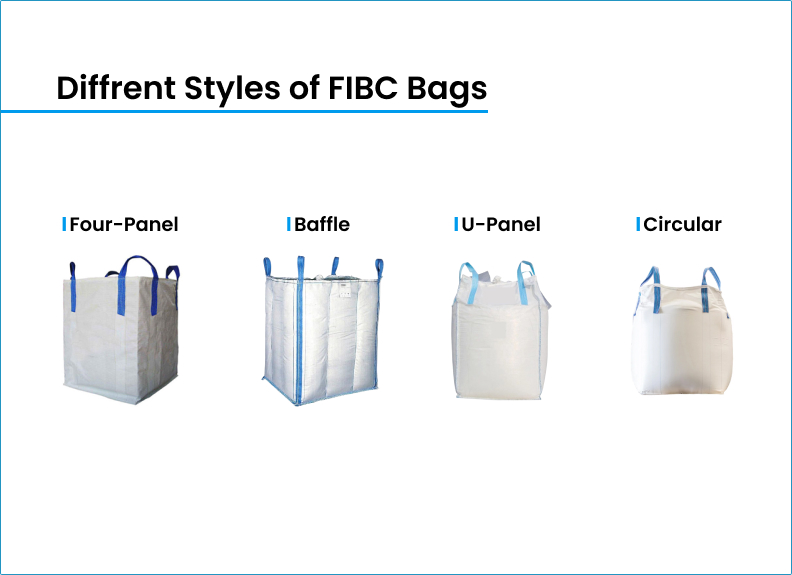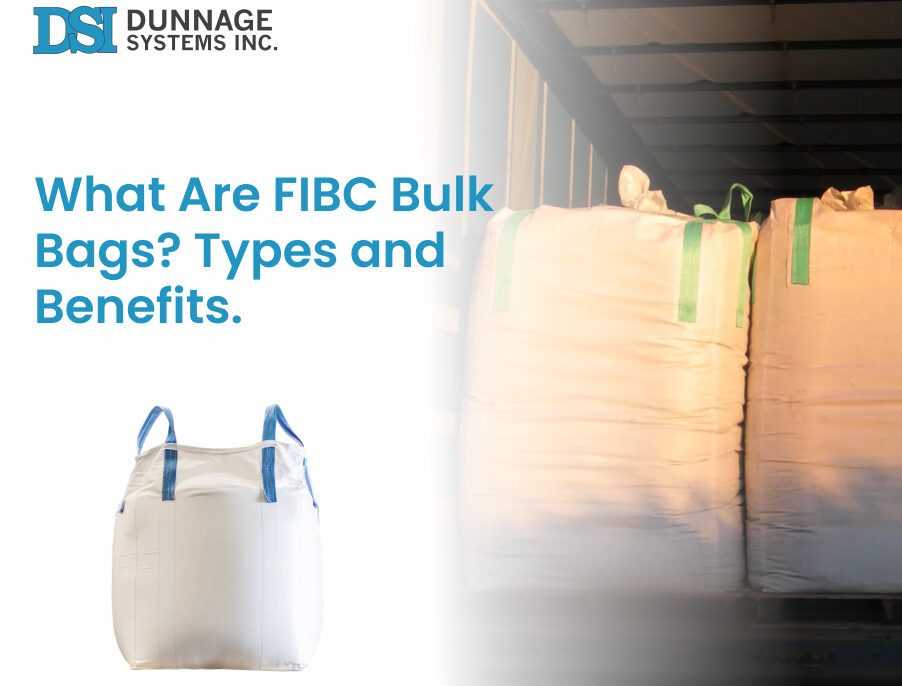Flexible Intermediate Bulk Containers, commonly known as FIBC bulk bags, are an important solution for packaging. They help manage the massive material volumes in different industries. These bags mainly transport and store dry and flowable goods.
Various bulk bags meet particular needs and offer effectiveness and environmental advantages.
This blog will describe the different FIBC bag types and their benefits, helping businesses in selecting the best one for their requirements.
Let’s dive right in and explore this topic without delay!
What is an FIBC Bulk Bag?
FIBC bulk bags are large and durable bags developed for transporting and storing bulk materials easily. It is made using woven polypropylene and helps various industries (Agriculture, chemical processing, construction, etc.) where management of large quantities of flowable and dry goods is important.
Bulk bags offer affordable and reliable solutions that help to,
- Decrease packaging waste
- Minimize storage space requirements
- Improve handling efficiency
They are lightweight but have a strong structure to offer safe transport while managing different capacities. It ensures safe and efficient bulk material management with different designs, which include,
- Standard
- Food-grade
- Conductive
Types of FIBC Bulk Bags
Overview of different FIBC bulk container bags, each made to address specific industry needs.
Type A FIBC Bags – Standard Bags for Non-Hazardous Goods
These bags are basic, all-purpose bulk containers, made to transport and store harmless goods. They are made from woven polypropylene that does not provide static protection. These bags are commonly used in industries like,
- Agriculture
- Construction
- Food processing
These lightweight and durable bags help to decrease packaging expenses and ensure safe shipping. It offers large storage capacity and easy management for dry and flowable products such as,
- Grains
- Fertilizers
- Powdered goods
When materials move inside these bags, static electricity is generated, especially while filling and emptying. That is why it is unsafe for hazardous materials and unsuitable for flammable or high-temperature environments.
Uses of Type A Bags:
- Safe for non-hazardous materials
- Suitable for locations that do not have fire risks
Avoid Using Type A Bags For:
- To transport flammable or hazardous materials
- Areas with flammable gases or high-temperature environments
Type B FIBC Bags – Anti-Static Properties for Dry Combustible Materials
These bags are just like type A, but they are made from low breakdown voltage materials. It helps to avoid dangerous propagating brush discharges (PBD), a high-energy static discharge that can generate ignition.
However, they do not actively reject electrostatic blast. It means normal brush discharge can still happen, which increases risks in a specific environment. As these bags do not have grounding abilities, they cannot be antistatic FIBCs, but are safer than type A.
Uses of Type B Bags:
- To ship dry, flammable powders more safely.
- Suitable for environments without flammable solvents or gases.
- Effective in areas where dust has ignition energies below 3 mJ, decreasing spark risks.
Avoid Using Type B Bags For:
- Not suitable for highly flammable or hazardous materials, as normal brush discharges can still generate ignition.
- Cannot be used where grounding is needed, as these bags do not completely dissipate static electricity.
Type C FIBC Bags – Conductive Bags for Preventing Electrostatic Hazards
These bulk bags, also known as conductive or groundable FIBCs, are used to transport and store materials that are flammable due to static electricity. Type C bags are originally made from conductive materials. However, advanced type C bags use non-conductive polypropylene material, which is interwoven with conductive yarns, generally in a grid pattern.
The conductive yarns must be interconnected and properly connected to the ground to ensure goods safety. This grounding blocks static build-up and decreases the chances of accidental explosion. However, as grounding needs manual input, human errors in proper connection increase the safety risks.
Uses of Type C Bags:
- Store and transport flammable powders that can generate static electricity.
- Ideal for high-risk environments with flammable vapors, gases, or dust, where static sparks might generate explosions.
Avoid Using Type C Bags For:
- When there is no proper grounding, like the ground connection is missing or damaged, this compromises safety.
- There is an electrical conflict between the bag and the grounding point, which prevents static electricity from being safely discharged.
- Extremely flammable environments where even a small spark can ignite materials with a minimum ignition energy of less than 1,000 mJ.
Type D FIBC Bags – Dissipative Bags for High-Risk Environments
Type D FIBCs are antistatic bulk bags made using special static-protective fabric to prevent electric sparks. Unlike type C bags, which need grounding to dissipate static electricity, these bags do not require any grounding for safety purposes. They are developed to automatically terminate static buildup, which makes them safer for the environments where flammable materials are available.
By using CROHMIQ fabric, these FIBCs remove the risk of grounding failures.
Uses of Type D Bags:
- Store and transport flammable powders that can generate static electricity.
- Ideal for high-risk environments with flammable vapors, gases, or dust, where static sparks might generate explosions.
Avoid Using Type D Bags For:
- The surface is coated with materials like grease, which can decrease its antistatic effectiveness.
Difference Between Type A, Type B, Type C vs Type D FIBC Bags
| Type | Material | Electrostatic Properties | Safe Usage | Unsafe Usage |
| Type A | Standard woven polypropylene | No protection against static | Used for non-flammable materials where no risk of static charge buildup exists | Not for use with flammable or combustible |
| Type B | Woven polypropylene with lower breakdown voltage | Prevents highly energetic propagating discharges but does not dissipate static charge | Suitable for dry, flammable powders where explosive gases or vapors are not present | Not for use in environments where flammable gases or vapors may be present |
| Type C | Conductive fabric with interconnected grounding | Requires grounding to safely dissipate static electricity | Used in environments where flammable vapors, gases, or dusts are present | Not safe if grounding is neglected or damaged |
| Type D | Antistatic fabric with built-in charge dissipation | Does not require grounding; prevents sparks and brush discharges | Used safely in flammable or explosive environments without needing grounding | Not effective if contaminated or coated with conductive materials |
Diffrent Styles of FIBC Bags
FIBC bulk bags have various designs suited for different storage and transportation requirements. Each type has unique structural properties that impact how properly they maintain their shape when being loaded.

Four-Panel
- Structure: It is developed using four different fabric panels. They are stitched together to shape the sides, with an extra piece for the bottom side.
- Shape Behaviour: It maintains a cube-like shape much better compared to circular or U-panel bags.
- Durability: Strong resistance to stretching and losing shape.
- Best Use Cases: Ideal for products that need solid shape retention throughout storage and transport.
U-Panel
- Structure: It is developed using two fabric panels stitched together in a “U” shape.
- Shape Behaviour: They are more stable compared to circular bags and maintain a better square shape when being filled.
- Durability: Moderate resistance to stretching.
- Best Use Cases: Ideal for products that need a more defined shape, along with being cost-effective.
Circular
- Structure: It is developed using a continuous woven tube of fabric.
- Shape Behaviour: They do not maintain a square shape when being loaded; they bulge at the sides.
- Durability: They have lower structural durability compared to other designs.
- Best Use Cases: Ideal for products where shape retention is not important.
Baffle
- Structure: It is developed using extra internal fabric baffles stitched into each corner.
- Shape Behaviour: They have the most stable design, which maintains a perfect cube shape even when being loaded.
- Durability: They have high structural durability that minimizes expansion.
- Best Use Cases: Ideal for stacking and increasing storage efficiency.
Benefits of Using FIBC Bulk Bags
These bags offer many advantages for industries when it comes to storing and transporting materials safely.
- Cost-effective
- Decreased transportation costs as they have a lightweight design.
- Decreased packaging costs compared to hard containers.
- Efficient storage and transport
- They can manage large quantities of materials in a single bag.
- They are easy to store and transport, and save warehouse space.
- Wide-ranging uses
- They are suitable for transporting powders, granules, chemicals, and agricultural products.
- They have different designs that meet different industry requirements.
- Improved safety and reduced contamination
- They decrease the chances of products getting dirty by offering dust-proof and moisture-resistant variants.
- Type C and D bags prevent electrostatic dangers.
- Eco-friendly and reusable
- Many bags can be reused, which decreases waste.
- Many types are recyclable, making them a more environmentally friendly option.
- Easy handling and filling
- They are developed for comfortable lifting using forklifts and cranes.
- They offer different discharge and filling options for proper loading and unloading.
Choosing the Right FIBC Bags Manufacturer
Factors to Consider When Selecting an FIBC Jumbo Bag Manufacturer
- Material Quality: Make sure they use high-grade polypropylene to improve durability.
- Customization Options: Choose manufacturers that offer custom solutions for various industries.
- Production Capacity: Choose a manufacturer capable of meeting your quantity requirements without delays.
- Cost & Pricing – Balance affordability with product reliability.
- Sustainability Practices – Make sure they offer eco-friendly or recyclable FIBC options.
- Customer Support – Reliable manufacturers provide clear communication and after-sales service.
Quality Standards and Certifications to Look For In a FIBC Bag Manufacturer
- ISO 9001 – Guarantees a high standard of quality management.
- FSSC 22000 / BRC Certification – Important for food-grade bulk bags.
- UN Certification – Necessary for dangerous material transportation.
- ASTM Standards – Ensure compliance with industry regulations for durability and strength.
- REACH Compliance – Ensure bags meet EU safety regulations regarding chemicals.
Industries That Use FIBC Bulk Container Bags
1. Agriculture
- Used to store and transport grains, seeds, fertilizers, and animal feed.
- Prevent crops from contamination and moisture, as well as ensure easy management.
2. Mining & Minerals
- Used to store and transport bulk materials like sand, gravel, coal, and metal ores.
- Heavy-duty FIBC bags deal with rough handling in mining operations.
3. Chemicals & Pharmaceuticals
- Used to store and transport powders, granules, and dangerous materials.
- Type C & D FIBC bags prevent electrostatic risks.
4. Food Processing
- Used to store and transport flour, sugar, salt, and additives.
- Food-grade FIBC bags follow strict hygiene and safety regulations.
Conclusion
FIBC bulk bags change the way various industries manage bulk storage and shipping of materials. They offer different types and structural designs to deliver customized solutions.
Choosing the right type and style helps businesses to maintain productivity without compromising safety. Moreover, choosing the right FIBC bags manufacturer ensures quality and compliance with industry standards.
As businesses keep focusing on durability and efficiency, these bulk containers will remain a popular choice when it comes to secure and better material handling.

Source: https://dunnagesystems.com/fibc-bulk-bags-types-and-benefits/



